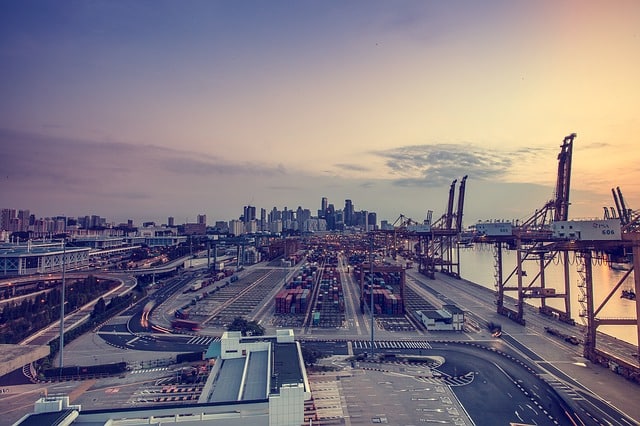Shipyard workers, including members of the U.S. Navy, have long faced high risks of asbestos exposure and resulting mesothelioma. Shipbuilding once used asbestos for its light weight, strength, and fire resistance from the boiler room to cabin ceiling tiles.[1] This put millions of workers, crew, and veterans at risk of developing asbestos illnesses.

How Was Asbestos Used in Shipyards?
The United States became a major center for shipbuilding during World War II. The shipbuilding boom began with naval ships but continued into peacetime with ships constructed for transport and commerce.
This booming industry required many workers. Until asbestos regulations were updated in the late 1970s, millions of people working in shipyards handled or worked near asbestos.
Shipyards have a long history of using asbestos, a natural mineral that has been used extensively in nearly all ship components. Asbestos is inexpensive, abundant, lightweight, strong, and naturally resists heat and fire.
The positives of asbestos made it seemingly perfect for shipbuilding. Ships need materials that are strong but not heavy. Also, using materials that resist the spread of fire is essential since shipboard fires can be extremely dangerous, especially at sea.
Asbestos Products Used in Shipyards
Asbestos was used in hundreds of materials and components in ship construction and repair. These are some examples of asbestos components shipyard workers may been in contact with:
- Pipe insulation
- Spray-on insulation
- Other types of insulation
- Boilers
- Pumps
- Concrete
- Floor tiling
- Doors
- Wall panels
- Sealants
- Adhesives
- Gaskets
- Pipes
- Boiler cladding
- Furnace firebricks
- Welding materials
- Safety equipment and protective clothing
What Diseases Do Shipyard Workers Get?
Asbestos fibers cause damage inside the body, which leads to illness in some people. Asbestos can cause these illnesses decades after exposure:
- Pleural mesothelioma
- Peritoneal mesothelioma
- Pericardial mesothelioma
- Lung cancer
- Other types of cancer
- Asbestosis
- Pleural plaques
- Chronic Obstructive Pulmonary Disease (COPD)
What Were the Asbestos Exposure Risks to Past Shipyard Workers?
Exposure to asbestos in shipyards occurred extensively in the past. After asbestos was determined to be a health risk, legislation passed in the 1970s restricted its use and ensured safety regulations, training, and equipment protected workers.
Anyone who worked in a shipyard while asbestos was in use could have been exposed, but some had higher risks. Shipyard employees who were potentially exposed to asbestos on the job include:
- Welders
- Electricians
- Machine operators
- Crane operators
- Repair workers
- Demolition or shipbreaking workers
- Laborers
- Longshoreman
- Pipefitters
- Ironworkers
- Carpenters
Even those workers who moved asbestos-containing materials from one part of a shipyard to another likely encountered asbestos.
What Else Are Shipyard Workers Exposed to?
Asbestos is just one of many harmful substances that shipyard workers might have come in contact with on the job. Workers should be trained to work safely with these chemicals and be given protective gear. Still, there is always a risk of exposure to these and other toxic materials:
- Benzene
- Cadmium
- Chromium VI
- Coal tar pitch
- Lead
- Nickel
- Paints
- Radiation
- Smoke
- Solvents
- Welding fumes
- Wood dust
Was Asbestos Used in Navy Shipyards?
Most shipyards are now known to have exposed workers to asbestos for many years. While these cases have been documented, there are likely many more that have gone undocumented.
Workers at both naval shipyards and non-naval shipyards were exposed to asbestos. Navy veterans who served on ships or in shipyards were at risk of asbestos exposure. Civilian workers in Navy shipyards were also at risk.
Are Current Shipyard Workers at Risk of Asbestos Exposure?
Extensive asbestos use in ships and shipyards began with World War II and extended into the 1960s and early 1970s. Workers at that time were at the greatest risk of becoming ill because they handled materials directly or worked around them.
Modern shipbuilders are still at risk. Asbestos regulations limit the use of this mineral, but it has not been completely banned. While there are bans on spray-on asbestos insulation, asbestos can still be used in other types of insulation.
Current shipyard workers are at risk of exposure to asbestos, mostly from materials in older ships. Repairs, maintenance, and restoration often expose old asbestos materials, causing loose fibers to enter the air as dust.
For example, cutting into pipe insulation, removing ceiling tiles, or dismantling an old boiler can expose old asbestos and send fibers into the air where workers can inhale them.
How Are Shipyard Workers Today Protected from Asbestos?
The risks of exposure in modern shipyards are much lower in the past but still significant. While asbestos is not used as heavily, it persists in some materials and in many shipyards.
The Occupational Safety and Health Administration (OSHA) sets asbestos safety standards and regulations to protect shipyard workers from asbestos and other hazards.[2]
These include strict exposure limits, monitoring for asbestos, protective gear and training, safety procedures, clear communication about risks, and more.
Any shipyard workers who do not feel their employers are following the OSHA guidelines can file a complaint to begin an investigation.
Research Shows Asbestos Harmed Shipyard Workers
Numerous studies have been conducted with shipyard workers to determine the amount and effect of asbestos exposure in this population:
- Studies have found that an overwhelming number of shipyard employees have asbestos fibers in the tissue of their lungs and chest cavities.[3]
- These workers also have higher than typical rates of illnesses related to asbestos, like asbestosis and mesothelioma.[4][5] Many of these studies were conducted in the 1960s and played an important role in bringing asbestos dangers to light and led to better regulations to protect workers.
- A review of the effects of asbestos in shipyards takes a global view. It found that workers around the world have been exposed to asbestos, with many getting sick later. In Japan, according to the study, shipyard workers are still being diagnosed with asbestos even though the country completely banned it in the 1970s. The review also warns that asbestos still lingers in U.S. ships and shipyards, putting workers at risk.[6]
Can Shipyard Workers Get Compensation for Asbestos Exposure?
If you worked in a shipyard and now have an asbestos illness like mesothelioma, you have legal options for seeking compensation.
Asbestos Lawsuits
The companies that supplied asbestos materials to shipyards are liable for exposure and illness in workers. Victims of exposure can file lawsuits against these companies to seek a settlement or jury verdict.
If you’re unsure which companies were involved, an asbestos attorney can help. They are experts at identifying exposure locations and responsible parties. They can review your case for free and help you start a lawsuit if that is an option.
Asbestos Trust Funds
Many companies responsible for shipyard asbestos exposure went bankrupt due to the liabilities. As part of the process, they had to set up trust funds to compensate workers who got sick later. You might be eligible to file a claim for compensation with an asbestos trust.
How Can Navy Veterans Seek Compensation?
Navy veterans have higher rates of mesothelioma than the general population because of the asbestos used on ships and in shipyards. If you served in Navy shipyards, you can file a lawsuit or an asbestos trust fund claim.
Another option for seeking compensation is to claim disability benefits from the VA. The VA gives mesothelioma a disability rating of 100%.
Examples of Shipyard Asbestos Lawsuits
Many shipyard employees have filed lawsuits to seek justice and compensation for illnesses resulting from asbestos exposure on the job. In 2011, a former employee of Newport News Shipbuilding received a settlement of $25 million.
Exxon Corporation was the defendant and owner of oil tankers the man worked on in the 1960s and 1970s. The court ruling found Exxon knew about harmful asbestos on its ships but did nothing to warn workers.
The family of a Puget Sound Naval Shipyard employee filed another successful lawsuit. The man removed asbestos insulation from older ships. The judge in the case decided that the Foster Wheeler Corporation was negligent in the man’s death because they failed to warn workers of the risks of asbestos.
Johns Manville and Shipyard Asbestos
Many companies manufactured shipping materials that contained asbestos. Johns Manville was one of the earliest companies to produce asbestos-containing materials for shipbuilding.
Since asbestos was used extensively in shipbuilding in the past, many of these companies have gone bankrupt. Johns Manville was the first to file for bankruptcy.
When it did, it also formed one of the first asbestos trust funds. These trust funds are organized to provide money for ongoing personal injury cases related to asbestos products. So far, victims have received more than $4 billion from the trust.
Shipyards have always been dangerous places to work; however, shipyard workers should not have to worry about asbestos or illnesses that can come from exposure.
Current regulations limit the use of this dangerous mineral but have come too late for thousands of workers who developed mesothelioma, asbestosis, or lung cancer. These workers suffered because of asbestos, and many companies have paid a high financial price for it.
Other Companies That Supplied Asbestos Products to Shipyards
Johns Manville was a major supplier of asbestos materials and components to shipyards but was far from the only one. Some of the many other companies that supplied asbestos products to shipyards include:
- Amatex Corporation
- Anchor Packing Company
- Babcock & Wilcox
- Bendix Corporation
- Burnham Holdings
- Foster Wheeler
- GAF Corporation
- Garlock Sealing Technologies
- Ingersoll Rand
- Keasbey & Mattison
- M.H. Detrick Company
- U.S Steel
Shipyards With Known Asbestos Use
Any shipyard that operated from the 1940s through the 1970s likely used asbestos and put workers at risk of exposure. These are just some of the major sites of asbestos use and exposure in shipyards around the U.S.:
- Alabama Dry Dock and Shipping Company
- Albina Shipyard
- Avondale Shipyard
- Barbours Cut Container Terminal
- Bethlehem Steel Corporation
- Bremerton Puget Sound Naval Shipyard
- Brooklyn Navy Yard
- Brown Shipbuilding
- Caddell Dry Dock and Repair Co., Inc.
- Mare Island Naval Shipyard
- Charleston Naval Shipyard
- Consolidated Steel Corporation
- Curtis Bay Coast Guard Yard
- Defoe Shipbuilding Company
- Duwamish Shipyard
- Naval Submarine Base New London
- Ingalls Shipbuilding
- Hunters Point Naval Shipyard (San Francisco Naval Shipyard)
- Kane Shipbuilding
- Kaiser Shipyards
- Lockheed Shipbuilding
- Moore Dry Dock
- New York Shipbuilding Corporation
- Orange, Texas Shipyards
- Pearl Harbor Naval Shipyard
- Seward Ships Drydock
- Sun Shipyard and Drydock
- Washington Navy Yard
- Willamette Iron and Steel Works

Mary Ellen Ellis
WriterMary Ellen Ellis has been the head writer for Mesothelioma.net since 2016. With hundreds of mesothelioma and asbestos articles to her credit, she is one of the most experienced writers on these topics. Her degrees and background in science and education help her explain complicated medical topics for a wider audience. Mary Ellen takes pride in providing her readers with the critical information they need following a diagnosis of an asbestos-related illness.

Dave Foster
Page EditorDave has been a mesothelioma Patient Advocate for over 10 years. He consistently attends all major national and international mesothelioma meetings. In doing so, he is able to stay on top of the latest treatments, clinical trials, and research results. He also personally meets with mesothelioma patients and their families and connects them with the best medical specialists and legal representatives available.
References
- Hedley-White, J. and Milamed, D.R. (2008, September). Asbestos and Ship-Building: Fatal Consequences. Ulster. Med. J. 77(3), 191-200.
Retrieved from: https://www.ncbi.nlm.nih.gov/pmc/articles/PMC2604477/ - Occupational Safety and Health Administration. (n.d.). Shipyard Industry Standards.
Retrieved from: https://www.osha.gov/sites/default/files/publications/OSHA_shipyard_industry.pdf - Dodson, R.F., Williams Jr., M.G., Corn, C.J., Brollo, A., and Bianchi, C. (1990, October). Asbestos Content of Lung Tissue, Lymph Nodes, and Pleural Plaques from Former Shipyard Workers. Am. Rev. Respir. Dis. 142(4), 843-7.
Retrieved from: https://www.atsjournals.org/doi/abs/10.1164/ajrccm/142.4.843?journalCode=arrd - Murphy, Jr. ,R.L.H., Ferris, Jr., B.G., Burgess, W.A., Worcester, J., and Gaensler, E.A. (1971, December 2). Effects of Low Concentrations of Asbestos — Clinical, Environmental, Radiologic and Epidemiologic Observations in Shipyard Pipe Coverers and Controls. N. Engl. J. Med. 285, 1271-8.
Retrieved from: https://www.nejm.org/doi/pdf/10.1056/NEJM197112022852301 - Selikoff, I.J., Lilis, R., and Nicholson, W.J. (1979) Asbestos Disease in United States Shipyards. Health Hazards of Asbestos Exposure. 330(1), 295-312.
Retrieved from: https://onlinelibrary.wiley.com/doi/10.1111/j.1749-6632.1979.tb18732.x/abstract - Beckett, W.S. (2007, October). Shipyard Workers and Asbestos: A Persistent and International Problem. Occup. Environ. Med. 64(10), 639-41.
Retrieved from: https://www.ncbi.nlm.nih.gov/pmc/articles/PMC2078396/


